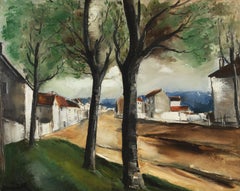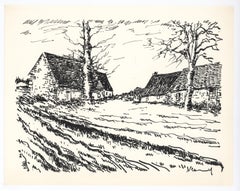Questions & Answers
Our trusted network of 1stDibs sellers answer common questions
What are the main characteristics of Fauvism paintings?
1 Answer

Fauvism is a style of painting that includes a few, distinct characteristics. It’s known for a radical use of unnatural colors, shows strong expression and emotions, and reflects bold brush strokes. Shop a collection of authentic Fauvism-style paintings on 1stDibs.
1stDibs ExpertApril 5, 2022
Related Questions
- What are the characteristics of Fauvism?1 Answer
- What are the main characteristics of Art Deco?1 Answer
- What are the main characteristics of minimalist art?1 Answer
- What are the characteristics of Baroque Dutch painting?1 Answer
- What are the characteristics of Impressionism?1 Answer
Shop for Maurice de Vlaminck Art on 1stDibs
La Route by Maurice de Vlaminck - Landscape painting
By Maurice de Vlaminck
Located in London, GB
*PLEASE NOTE UK BUYERS WILL ONLY PAY 5% VAT ON THIS PURCHASE.
La Route by Maurice de Vlaminck (1876-1958)
Oil on canvas
64.8 x 81 cm (25 ¹/₂ x 31 ⁷/₈ inches)
Signed lower left, Vlam...
Category
Mid-20th Century Figurative Paintings
Materials
Canvas, Oil
Unknown
By Maurice de Vlaminck
Located in Norwich, GB
Maurice de Vlaminck was a French painter, best known as one of the spearheads of the Fauvism movement at the start of the 20th century. His reputation rests predominantly on his land...
Category
Early 20th Century Fauvist Landscape Drawings and Watercolors
Materials
Watercolor
"Les Challonges" original lithograph
By Maurice de Vlaminck
Located in Henderson, NV
Medium: original lithograph. Printed in Paris in 1958 at the Mourlot atelier, and published by Andre Sauret in an edition of 2000. Size: 9 1/2 x 12 1/4 inches (242 x 310 mm). Signed ...
Category
1950s Landscape Prints
Materials
Lithograph
La Route nationale
By Maurice de Vlaminck
Located in Basel, CH
MAURICE DE VLAMINCK
(PARIS, 1876 – RUEIL-LA-GADELIÈRE, 1952)
La Route nationale
Vers 1935
Huile sur toile
54 x 65 cm
Signée en bas à gauche
Certificat Wildenstein – Plattner
La route...
Category
1930s Paintings
Materials
Oil
original woodcut
By Maurice de Vlaminck
Located in Henderson, NV
Medium: original woodcut. Printed in Paris in 1927 on Arches paper, and issued in a limited edition of 750 for the artist's own "Histoires & Poemes d...
Category
1920s Prints and Multiples
Materials
Woodcut
Bougival
By Maurice de Vlaminck
Located in Fairlawn, OH
Bougival
Woodcut, 1914
Signed and numbered in pencil
Edition 30, this numberd 22
Printed on laid Van Gelder Zonen paper
Published by Henri Kanweiler, Paris
Printed by Paul Birault, Paris
Bougival is located west of Paris, on the left bank of the River Seine.
This woodcut was inspired by Vlaminck's 1905 Fauvist masterpiece of the same title in the collection of the Detroit Institute of Art.
An impression of this image is in the Yale Univeristy Art Gallery,
Condition: Very slight sun staining, otherrwise very good
Image/block size: 13 1/4 x 16 1/4 inches
Sheet size: 19 1/8 x 22 1/8 inches
Reference: Walterskirchen 11b
Maurice de Vlaminck (4 April 1876 – 11 October 1958) was a French painter. Along with André Derain and Henri Matisse, he is considered one of the principal figures in the Fauve movement, a group of modern artists who from 1904 to 1908 were united in their use of intense colour.] Vlaminck was one of the Fauves at the controversial Salon d'Automne exhibition of 1905.
Life
Maurice de Vlaminck was born on Rue Pierre Lescot in Paris. His father Edmond Julien was Flemish and taught violin and his mother Joséphine Caroline Grillet came from Lorraine and taught piano His father taught him to play the violin.[3] He began painting in his late teens. In 1893, he studied with a painter named Henri Rigalon on the Île de Chatou In 1894 he married Suzanne Berly. The turning point in his life was a chance meeting on the train to Paris towards the end of his stint in the army. Vlaminck, then 23 and already active in anarchist circles in Paris, met an aspiring artist, André Derain, with whom he struck up a lifelong friendship.] When Vlaminck completed his army service in 1900, the two rented a studio together, the Maison Levanneur, which now houses the Cneai,[6] for a year before Derain left to do his own military service. In 1902 and 1903 he wrote several mildly pornographic novels illustrated by Derain. He painted during the day and earned his livelihood by giving violin lessons and performing with musical bands at night.
Vlaminck participated in the controversial 1905 Salon d'Automne exhibition. After viewing the boldly colored canvases of Vlaminck, Henri Matisse, André Derain, Albert Marquet, Kees van Dongen, Charles Camoin, and Jean Puy, the art critic Louis Vauxcelles disparaged the painters as "fauves" (wild beasts), thus giving their movement the name by which it became known, Fauvism.
In 1911, Vlaminck traveled to London and painted by the Thames. In 1913, he painted again with Derain in Marseille and Martigues. In World War I he was stationed in Paris, and began writing poetry. Eventually he settled in Rueil-la-Gadelière, a small village south-west of Paris. He married his second wife, Berthe Combes, with whom he had two daughters. From 1925 he traveled throughout France, but continued to paint primarily along the Seine, near Paris. Resentful that Fauvism had been overtaken by Cubism as an art movement Vlaminck blamed Picasso "for dragging French painting into a wretched dead end and state of confusion". During the Second World War, Vlaminck visited Germany and on his return published a tirade against Picasso and Cubism in the periodical Comoedia in June 1942. Vlaminck wrote many autobiographies.
Vlaminck died in Rueil-la-Gadelière on 11 October 1958.
Artistic career
Two of Vlaminck's groundbreaking paintings, Sur le zinc (At the Bar) and L'homme a la pipe (Man Smoking a Pipe) were painted in 1900.
For the next few years Vlaminck lived in or near Chatou (the inspiration for his painting houses at Chatou), painting and exhibiting alongside Derain, Matisse, and other Fauvist painters. At this time his exuberant paint application and vibrant use of colour displayed the influence of Vincent van Gogh. Sur le zinc called to mind the work of Toulouse-Lautrec and his portrayals of prostitutes and solitary drinkers, but does not attempt to probe the sitter's psychology—a break with the century-old European tradition of individualized portraiture. According to art critic Souren Melikian, it is "the impersonal cartoon of a type. In his landscape paintings, his approach was similar. He ignored the details, with the landscape becoming a vehicle through which he could express mood through violent colour and brushwork. An example is Sous bois, painted in 1904. The following year, he began to experiment with "deconstruction," turning the physical world into dabs and streaks of colour that convey a sense of motion. His paintings Le Pont de Chatou (The Chatou Bridge), Les Ramasseurs de pommes de terre (The Potato Pickers...
Category
1910s Fauvist Landscape Prints
Materials
Woodcut


